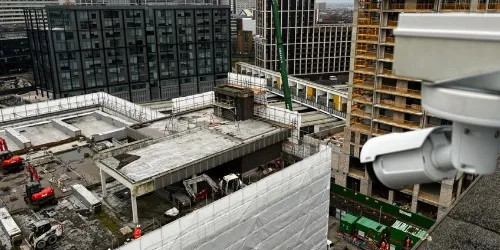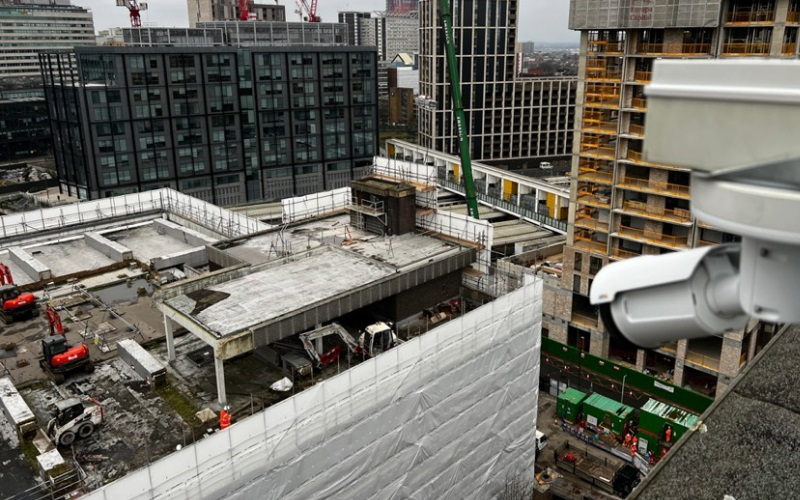

View navigation
Contents
[show]Looking to get the best out of your construction time lapse video cameras? WCCTV's helpful guide walks you through how to position your cameras for the best results.
Filming a Time Lapse Video is a unique way of documenting the key milestones of your construction projects, bringing them to life in a short-form video format.
A time lapse video delivers several benefits for your company way beyond the end of the project, including increased PR, marketing and branding opportunities, and engagement with your teams and clients.
But a time lapse video is only as effective as the footage it captures, and many environmental factors can impact the quality of your final video.
WCCTV, the USA's #1 supplier of time lapse video cameras, below offers some best practice guidance for positioning your camera to ensure maximum engagement from your final video.

Your first consideration should be which position and/or angle will give you the best overview of the whole site. This will likely involve installing the camera at a high vantage point to get the maximum coverage of the site as it develops.
Consider at the outset of your projects whether you will need to move the camera as the project develops. If you're building a high-rise structure, will your original camera position still work as the project nears completion?
The camera's position may also be compromised by other factors, too, such as tall machinery being utilized onsite that could block the camera's field of view.
Finally, you'll need to decide whether one camera will be enough to give you the best result. It may be that large sections of work occur far away from the camera or even out of shot, so would multiple cameras be more effective?
Likewise, would having an internal and external camera provide a beneficial enhancement to your final results? In the video below, WCCTV provided the client internal and external timelapse filming services to deliver a full project overview.
Sun glare can have a detrimental impact on the quality of your footage, and, depending on the angle of your camera, it can potentially obscure large portions of daily activity.
Factor the sun's arc throughout the project (remembering that it will change through the seasons) and try to angle your cameras to best mitigate against glare.
Regularly reviewing your footage will help determine whether you have installed the camera at the best possible location to minimize the sun's glare.
Wind can also have a damaging impact on your time-lapse video project. Cameras that are not firmly secured can shake/move on windy days, severely impacting video quality.
For this reason, we advise against installing your cameras high up on long poles, attaching them to unsecured metalwork, or any unsecured surface.
Wherever you install the camera, ensure it is firmly secured to prevent wind or vibration movement year-round.
Rain can dampen more than your spirits; it can also ruin crucial parts of your time lapse video. Rain droplets can pool the camera's lens, causing images to become blurry and unusable.
To mitigate this as best as possible, you should fit your time-lapse cameras with a rain shield/guard. This will minimize the likely impact of an occurrence that is largely unavoidable.
The same can be said for dust and debris on your sites. Wind can pick up dust particles and deposit them on the lens of your cameras.
In this instance, a simple wipe of the camera lens is enough to prevent any major impact on your video, but be extremely careful not to nudge the camera's position when cleaning.
You want your finished time lapse video to be as visually appealing as possible and grab the attention of your potential clients when they are browsing your websites or social media.
Framing your image in a way that is easy on the viewer's eye can critically impact how much attention your video gets.
The guide below explains how to apply 'The Rule of Thirds' to frame your video best.
Testing and checking is the key way to mitigate against all of the issues listed above.
Review the footage you have gathered, ideally weekly, to highlight any adjustments you need to make to ensure the project isn't spoiled by camera movement or environmental factors. If your project is very short, it may be advisable to check every other day.
WCCTV has over 15 years of experience working with the construction industry, providing a 3-in-1 video solution for security, remote project management and time Lapse Video.
We will work in partnership with you during your projects to ensure we capture your projects' key milestones and deliver your perfect Time Lapse Video.
We will provide full post-project video editing services, including text overlay, music and removing any periods of inactivity so that you have an incredible highlights package to share across all your digital channels.
You'll also be given access to our time lapse portal so that you can download your progress videos at the push of a button and even embed the live video onto your website.
For more information on WCCTV’s Time Lapse Video cameras, get in touch today on 877-805 9475 or send us an email by clicking the button below.
Contact us
Ready to promote your projects and document your progress? Get in touch with our time lapse experts to request a quote for our filming and editing services.